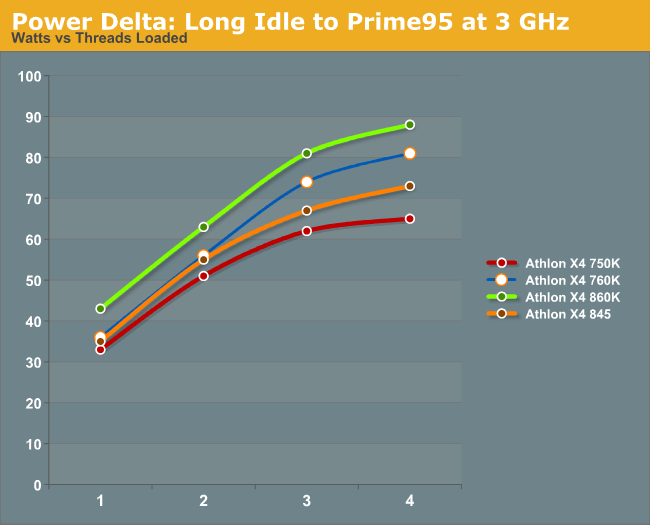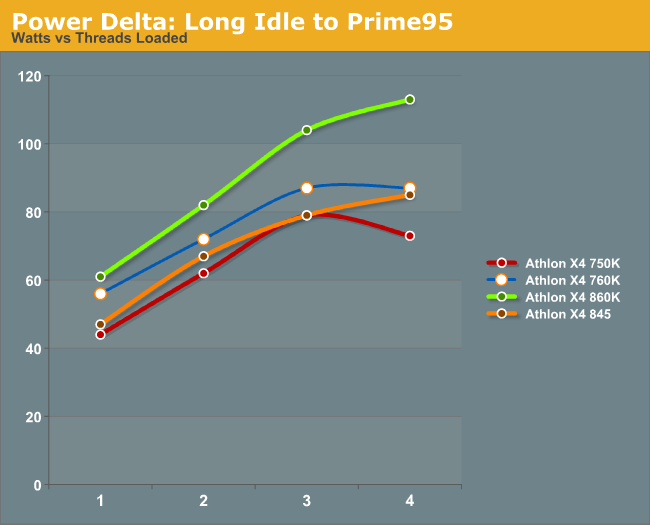AMD Carrizo Part 2: A Generational Deep Dive into the Athlon X4 845 at $70
by Ian Cutress on July 14, 2016 9:00 AM ESTPower Consumption
Power consumption was tested on the system while in a single MSI GTX 770 Lightning configuration with a wall meter connected to the power supply. This power supply is 80PLUS rated, and as I am in the UK on a 230-240 V supply, leads to ~75% efficiency > 50W, and 90%+ efficiency at 250W, suitable for both idle and multi-GPU loading. This method of power reading allows us to compare the power management of the UEFI and the board to supply components with power under load, and includes typical PSU losses due to efficiency.
Our Power Consumption tests have changed slightly since our last review as we are testing out new ways to represent the power used by the CPU and the system. The current three standard tests start with a system at long idle, meaning that the OS turns off the monitor and enters a lower power state without going into S3. We then move into a standard idle state on the desktop, with no software running but the desktop on display. The system is then moved into high performance mode, and we run a one-minute OCCT test to identify peak power consumption.
Due to extended requests, our power consumption numbers also use Prime95 to load the system. We use Prime95's peak power consumption mode, testing 1/2/3/4 thread consumption at the wall with our power meter. P95 hits the peak power relatively quickly, making this a straightforward test to include. For CPUs above 4 threads, we typically manage powers of two, half the CPU, and the full CPU to get an accurate picture.
For this review, we performed the power analysis for all four main CPUs at the 3 GHz frequency (using automatic voltage on the motherboard), as well as at stock frequencies. The values shown are delta values to the long idle power consumption, due to power delivery variations.
Generational Power Consumption at 3 GHz
All four processors have a 2-3W difference moving from a long idle to an idle state, however it is clear that our Carrizo CPU, which we stated is well outside its normal efficiency window at the beginning of this review, has a very good response during OCCT loading.

These results are within 3-4W of the full loading provided by Prime95 as well. If we analyze the per core jumps from moving up the threads using Prime95, there are some interesting numbers to pick out.

All the processors increase their power consumption by ~20W when both modules are loaded, when moving from 1 core loading to 2 core loading. When moving to 3/4 core loading, it is obvious that as both modules are already running at high frequency, a smaller amount of power is needed for each to enable the second thread.
Power Consumption at Stock
For those keeping track, we were not able to source identical TDP rated processors for this test. While the Carrizo based Athlon is 65W, the other processors are at the 95W/100W level. This makes total power consumption numbers relatively processional, and it becomes interesting looking into how close each processor gets to its TDP.
In our testing, the X4 845 seems to go beyond its 65W TDP, pushing almost another 9W through our power meter. This is only 8W away from the X4 750K, which should be 35W ahead. However, it would seem that for the X4 845, P95 draws an extra 15W compared to OCCT, but for the X4 750K, it draws 10W less, showing how difficult it can be to retain consistency. It is worth noting that TDP ratings are difficult to interpret in this way - the processors coming out of the fabs will have a statistical variation to their operating voltage, and this differs between samples. A good sample of a high TDP compared to a bad sample of a low TDP might seem to generate an interesting story, however without having access to several dozen units it can be strained to draw many conclusions.

Looking at the Prime95 core-loading numbers, we see a similar pattern to what happened at 3 GHz, despite the X4 760K getting the same power reading for 3/4 core loading and the X4 750K actually decreasing in power with four loaded threads.










131 Comments
View All Comments
TheinsanegamerN - Monday, July 18, 2016 - link
carrizo is gimped because it's a bulldozer product. AMD should have stuck with k10 cores on their APUs.Lolimaster - Saturday, July 16, 2016 - link
Unless they axed BR in favor of non-APU Zen and bring Raven Ridge early 2017.Lolimaster - Saturday, July 16, 2016 - link
They were nice in 2014.We should have a nice 20nm 768SP APU in 2015 with a full L2 cache Excavator and fully mature 896SP 20nm early this year.
Remember the A8 3870K? That APU was a damn monster only hold back from being godly cause of their sub 3Ghz cpu speed, what we had after?
400SP VLIW5 2011 --> 384 VLIW4 2012 --> 384VLIW4 2013 --> 512SP GCN 2015 --> 512SP GCN 2016
Intel improved way faster (non "e" + edram igp's are near A8 level from being utter trash when the A8 3850 was release).
serendip - Saturday, July 16, 2016 - link
Still not attractive when a cheap Pentium kills it on single-threaded performance, which is what matters in real-world usage. AMD needs to make tablet chips to take the place of Intel Atoms. I'd love to have a 2W TDP APU with double the performance of Atom GMA graphics and similar single-threaded performance.One can dream...
TheinsanegamerN - Monday, July 18, 2016 - link
AMD powered surface 4 (non pro model) with LTE would be perfect.Too bad AMD abandoned that market. They had a good thing going with their cat cores, but they let that line wither on the vine.
leopard_jumps - Saturday, July 16, 2016 - link
Thanks for the review ! You should include Intel i7 for comparison . Here :http://www.guru3d.com/articles_pages/amd_athlon_x4...
Meteor2 - Saturday, July 16, 2016 - link
The latest microarchitecture from AMD based on the x86 instruction set was given the codename Excavator, using the fourth generation of AMD's Bulldozer cores, called Carrizo cores.' - Can someone explain that to me? Or are we saying these are Excavator Bulldozer Carizos??Calculatron - Saturday, July 16, 2016 - link
Fourth generation Bulldozer-style cores, named Carrizo.The architecture type/family is Bulldozer, this version/generation is called Excavator, and this specific kind of core is called Carrizo. The mobile version is called Carrizo-L, I think?
If you, or anyone you know, bought an FX-8350, they bought a second-generation Bulldozer product, and it was called Piledriver. Anyone who bought the A10-5800K also bought a second generation Bulldozer product, but it was called Trinity. Both of these were Vishera, since they were second-generation.
Lolimaster - Saturday, July 16, 2016 - link
No.The 1st APU platform featuring piledriver cores was called Trinity,
The 1st and only desktop FX platform featuring piledriver cores was called Vishera.
Calculatron - Saturday, July 16, 2016 - link
This is correct: I confused, and swapped, Piledriver and Vishera.Both the A10-5800K and FX-8350 were Piledriver, but they were Trinity and Vishera, respectively.